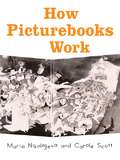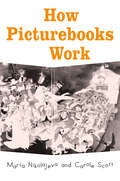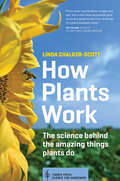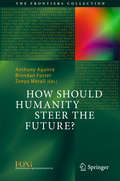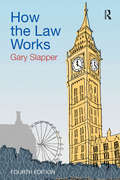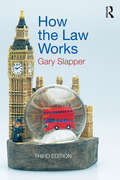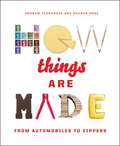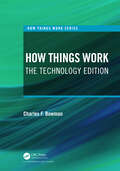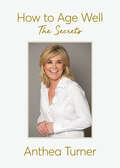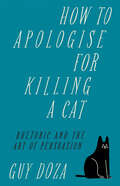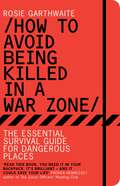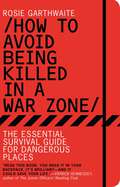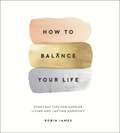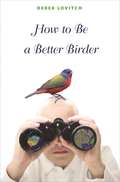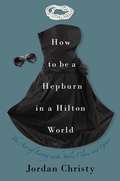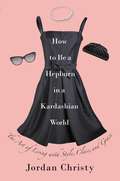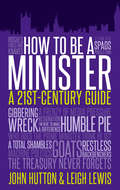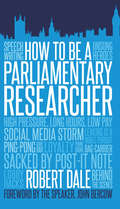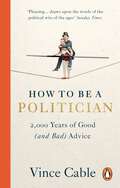- Table View
- List View
How People with Autism Grieve, and How to Help: An Insider Handbook
by Deborah LipskyThe book is an honest, first-hand account of how people with autism deal with the loss of someone in their life. It explores how people with autism feel and express the loss and how they come to terms with their grief, offering practical advice to parents and carers on how best to support someone with autism during these difficult times.
How Picturebooks Work (Children's Literature and Culture)
by Maria Nikolajeva Carole ScottHow Picturebooks Work is an innovative and engaging look at the interplay between text and image in picturebooks. The authors explore picturebooks as a specific medium or genre in literature and culture, one that prepares children for other media of communication, and they argue that picturebooks may be the most influential media of all in the socialization and representation of children. Spanning an international range of children's books, this book examine such favorites as Curious George and Frog and Toad Are Friends, along with the works of authors and illustrators including Maurice Sendak and Tove Jansson, among others. With 116 illustrations, How Picturebooks Work offers the student of children's literature a new methodology, new theories, and a new set of critical tools for examining the picturebook form.
How Picturebooks Work (Children's Literature and Culture #14)
by Maria Nikolajeva Carole ScottHow Picturebooks Work is an innovative and engaging look at the interplay between text and image in picturebooks. The authors explore picturebooks as a specific medium or genre in literature and culture, one that prepares children for other media of communication, and they argue that picturebooks may be the most influential media of all in the socialization and representation of children. Spanning an international range of children's books, this book examine such favorites as Curious George and Frog and Toad Are Friends, along with the works of authors and illustrators including Maurice Sendak and Tove Jansson, among others. With 116 illustrations, How Picturebooks Work offers the student of children's literature a new methodology, new theories, and a new set of critical tools for examining the picturebook form.
How Plants Work: The Science Behind the Amazing Things Plants Do
by Linda Chalker-ScottHorticulturist Linda Chalker-Scott illuminates the fascinating mysteries of the garden in this engaging and accessible introduction to plant physiology.
How Should Humanity Steer the Future? (The Frontiers Collection)
by Anthony Aguirre Brendan Foster Zeeya MeraliThe fourteen award-winning essays in this volume discuss a range of novel ideas and controversial topics that could decisively influence the course of human life on Earth. Their authors address, in accessible language, issues as diverse as: enabling our social systems to learn; research in biological engineering and artificial intelligence; mending and enhancing minds; improving the way we do, and teach, science; living in the here and now; and the value of play. The essays are enhanced versions of the prize-winning entries submitted to the Foundational Questions Institute (FQXi) essay competition in 2014. FQXi, catalyzes, supports, and disseminates research on questions at the foundations of physics and cosmology, particularly new frontiers and innovative ideas integral to a deep understanding of reality, but unlikely to be supported by conventional funding sources.
How the Law Works
by Gary Slapper‘How the Law Works is a gem of a book, for law students and for everyone else. It is a must read for anyone interested in how society is shaped and controlled via law.’ Dr Steven Vaughan, solicitor, Senior Lecturer, Birmingham Law School ‘How the Law Works is a comprehensive, witty and easy-to-read guide to the law. I thoroughly recommend it to non-lawyers who want to improve their knowledge of the legal system and to potential students as an introduction to the law of England and Wales.’ HH Judge Lynn Tayton QC Reviews of the first edition: ‘A friendly, readable and surprisingly entertaining overview of what can be a daunting and arcane subject to the outsider.’ The Law Teacher ‘An easy-to-read, fascinating book . . . brimful with curios, anecdote and explanation.’ The Times How the Law Works is a refreshingly clear and reliable guide to today’s legal system. Offering interesting and comprehensive coverage, it makes sense of all the curious features of the law in day to day life and in current affairs. Explaining the law and legal jargon in plain English, it provides an accessible entry point to the different types of law and legal techniques, as well as today’s compensation culture and human rights law. In addition to explaining the role of judges, lawyers, juries and parliament, it clarifies the mechanisms behind criminal and civil law. How the Law Works is essential reading for anyone approaching law for the first time, or for anyone who is interested in an engaging introduction to the subject’s bigger picture.
How the Law Works
by Gary SlapperHow the Law Works is a refreshingly clear and reliable guide to the legal system in the UK. Offering interesting and comprehensive coverage, it makes sense of all the curious features of the law in day to day life and in current affairs. Explaining the law and legal jargon in plain English, it provides an accessible entry point to the different types of law and legal techniques, as well as the impact of European law and human rights law. In addition to explaining the role of judges, lawyers, juries and parliament, it clarifies the mechanisms behind criminal and civil law. How the Law Works is essential reading for anyone approaching law for the first time, or for anyone who is interested in an engaging introduction to the subject’s bigger picture.
How the Law Works
by Gary SlapperHow the Law Works is a refreshingly clear and reliable guide to the legal system in the UK. Offering interesting and comprehensive coverage, it makes sense of all the curious features of the law in day to day life and in current affairs. Explaining the law and legal jargon in plain English, it provides an accessible entry point to the different types of law and legal techniques, as well as the impact of European law and human rights law. In addition to explaining the role of judges, lawyers, juries and parliament, it clarifies the mechanisms behind criminal and civil law. How the Law Works is essential reading for anyone approaching law for the first time, or for anyone who is interested in an engaging introduction to the subject’s bigger picture.
How the Law Works
by Gary Slapper‘How the Law Works is a gem of a book, for law students and for everyone else. It is a must read for anyone interested in how society is shaped and controlled via law.’ Dr Steven Vaughan, solicitor, Senior Lecturer, Birmingham Law School ‘How the Law Works is a comprehensive, witty and easy-to-read guide to the law. I thoroughly recommend it to non-lawyers who want to improve their knowledge of the legal system and to potential students as an introduction to the law of England and Wales.’ HH Judge Lynn Tayton QC Reviews of the first edition: ‘A friendly, readable and surprisingly entertaining overview of what can be a daunting and arcane subject to the outsider.’ The Law Teacher ‘An easy-to-read, fascinating book . . . brimful with curios, anecdote and explanation.’ The Times How the Law Works is a refreshingly clear and reliable guide to today’s legal system. Offering interesting and comprehensive coverage, it makes sense of all the curious features of the law in day to day life and in current affairs. Explaining the law and legal jargon in plain English, it provides an accessible entry point to the different types of law and legal techniques, as well as today’s compensation culture and human rights law. In addition to explaining the role of judges, lawyers, juries and parliament, it clarifies the mechanisms behind criminal and civil law. How the Law Works is essential reading for anyone approaching law for the first time, or for anyone who is interested in an engaging introduction to the subject’s bigger picture.
How Things Are Made: From Automobiles to Zippers
by Andrew TerranovaFor anyone curious about the nuts and bolts of human ingenuity, How Things Are Made is a fascinating exploration of the process behind the manufacture of everyday items. What are bulletproof vests made of? How do manufacturers get lipstick into the tube? How many layers are there in an iPhone screen? The answers to these questions and so much more fascinating information can be found in How Things Are Made, a behind-the-scenes look at the production everyday objects of all kinds, from guitars, sunscreen, and seismographs to running shoes, jet engines, and chocolate. Thoroughly revised and redesigned from the best-selling 1995 edition, How Things Are Made also contains three new entries by author Andrew Terranova. However, each page still contains informative step-by-step text along with detailed but easy-to-follow illustrations, diagrams, and sidebars to tell the stories behind the things we sometimes take for granted. For example, did you know that Edison didn't really invent the light bulb? Or that the first bar code was on a pack of Wrigley's Spearmint gum? Or that a maple seed inspired the design for the helicopter? Discover these fascinating anecdotes and much more in How Things Are Made.
How Things Work: The Technology Edition (How Things Work Series)
by Charles F. BowmanIt is beyond trite to say that technology is prevalent in our daily lives. However, many of us remain clueless as to how much of it works. Unfortunately, even for the curious among us, the Web is not always the best vehicle to acquire such knowledge: Information appears in fragments, some of it is incorrect or dated, and much of it serves as jargon-laden discussions intended for professionals. How Things Work: The Technology Edition will serve as a compendium of tutorials. Each section will focus on one technology or concept and provide the reader with a thorough understanding of the subject matter. After finishing the book, readers will understand the inner workings of the technologies they use every day and, more importantly, they will learn how they can make these tools work for them. In addition, the book will also inform readers about the darker side of modern technology: Security and privacy concerns, malware, and threats from the dark web.
How Things Work: The Technology Edition (How Things Work Series)
by Charles F. BowmanIt is beyond trite to say that technology is prevalent in our daily lives. However, many of us remain clueless as to how much of it works. Unfortunately, even for the curious among us, the Web is not always the best vehicle to acquire such knowledge: Information appears in fragments, some of it is incorrect or dated, and much of it serves as jargon-laden discussions intended for professionals. How Things Work: The Technology Edition will serve as a compendium of tutorials. Each section will focus on one technology or concept and provide the reader with a thorough understanding of the subject matter. After finishing the book, readers will understand the inner workings of the technologies they use every day and, more importantly, they will learn how they can make these tools work for them. In addition, the book will also inform readers about the darker side of modern technology: Security and privacy concerns, malware, and threats from the dark web.
How to Age Well: The Secrets
by Anthea TurnerHow to Age Well is a carefully researched, beautifully presented guide to ageing with style and grace. The author who is renowned for her own glamorous look, has spoken to and worked with literally dozens of beauty and fitness experts over the decades. Here she reveals their secrets, hacks and tips on how to always look one’s best, from achieving amazing skin, dealing with weight gain and the menopause, to spiritual well-being and contentment. This is a must-have companion, for every woman wanting to look and feel her best, packed full of stunning photographs and expertise from some of the top names in the beauty, fitness and wellness industries.
How to Apologise for Killing a Cat: Rhetoric and the Art of Persuasion
by Guy Doza‘Most books on persuasion teach the few how to sway the many. With wit and vim, Guy has given us something else: an X-ray into the tactics of those trying to change our minds and behaviour.’ - Stephen Krupin, former speechwriter for Barack Obama When Winston Churchill spoke in Parliament, he convinced an empire to go to war. When Martin Luther King spoke in Washington, he convinced millions to open their hearts to change. When Oprah Winfrey said: ‘Do what you have to do until you can do what you want to do,’ she also used rhetoric. As we have here, by deploying the rule of three to stress a point. Rhetoric - the art of persuasive speaking and writing – often gets a bad rap. In this dazzling, fast-paced guide, speechwriter Guy Doza rescues rhetoric from the shadows and showcases its immense power to change lives, for good and bad. Highlighting punchy sayings from Ancient Rome to modern marketing, he shows how leaders, businesses and even our own friends use rhetorical techniques every day to make convincing arguments. What’s more, this guide to rhetoric will show you how to learn to use this persuasive language in your own life: How to convince an investor to back your venture What to say to a potential lover in a bar And, the six rules of apology you should use if you ever accidentally run over the next-door neighbour’s cat... How to Apologise for Killing a Cat is a quick read, humorous and highly practicable. It decodes the tricks and techniques of rhetoric for everyday readers. It's the only book you need to make a convincing marketing pitch. It's the only book you need to give a rousing speech. It's the only book you need to write persuasively. It's the best book to explain the technique we've just used here. After reading this book, you will start to see the trick of rhetoric used everywhere. After reading this book, you will never see the world the same way again! About the author Guy Doza is a speechwriter and trainer. He has a Master’s degree in Rhetoric from the University of London and uses rhetoric in the speeches he writes for senior politicians and business leaders. He trains government speechwriters in logic and rhetoric. Introduction Have you ever had that unpleasant anxiety of taking your car to the mechanic and feeling like you’re being swindled? Most of you will probably know exactly what I am talking about. We don’t know how cars work, we don’t know what the parts are called and we don’t know how to fix them ourselves. This lack of knowledge makes us vulnerable and susceptible to exploitation, and we know it. So does the mechanic. Now, most mechanics are honest individuals, not rogues, but can we say the same of people who run countries and big companies? When it comes to ordinary life away from the car engine or central heating boiler, most of us don’t even realise just how vulnerable we are. People can use persuasive language to swindle us, cheat us, and exploit us to the hilt. And the worst part is that we are not even aware that it is happening. Welcome to rhetoric, the art of persuasion. Rhetoric is a superpower. It can alter the way we think, the way we behave and sometimes even the way we live our lives. And its most explosive charge lies in its subtlety. We need to be aware of how such persuasive language is used, not only so that we can be more persuasive ourselves, but defend ourselves against the rhetorical advances of those who would seek to exploit us. <strong
How to Avoid Being Killed in a War Zone: The Essential Survival Guide for Dangerous Places
by Rosie GarthwaiteEveryone needs this book if they want to know how to get out of difficult situations whether at home or abroad. Written by Rosie Garthwaite, whose career as a journalist started in war-torn Basra, this book combines practical advice with contributions from many journalists and commentators including Rageh Omar and John Simpson, who share their own experience and advice on surviving in difficult and dangerous situations. Topics include how to avoid being misunderstood; how to avoid bombs and booby traps; how to escape from a riot; how to deal with frostbite and heat exhaustion; how to avoid trouble in sex, love and war; and how cope if you have had a traumatic experience. The author conveys this wealth of practical, sensible advice in a very direct and personal way. In addition, readers hear the voices of many well-known journalists who share their experiences and advice in a very direct and personal way. This book is an enjoyable read as well as a true survival manual which can be enjoyed by both men and women (usually ignored by the 'boys' own' market) and by all ages especially travellers venturing away from home or to extreme destinations for the first time.Medical information has been vetted by Médecins Sans Frontières, one of the world's leading medical charities which specializes in warzones and other trouble spots.
How to Avoid Being Killed in a War Zone: The Essential Survival Guide for Dangerous Places
by Rosie GarthwaiteWhether you're a war correspondent or an aid worker, a tourist worried about an increasingly hostile world or an armchair traveler concerned that your own backyard is fast becoming a war zone, How to Avoid Being Killed in a War Zone will help you survive some of the world's most volatile environments. Well-traveled journalist Rosie Garthwaite offers practical advice drawn from her own personal experience and that of others, including many seasoned colleagues, who have worked in some of the world's most hostile regions. Topics covered include everything from avoiding land mines and hostage situations to amputating a limb and foraging for safe food. The book is a true survival manual (all medical advice has been vetted by doctors from Doctors Without Borders), but it is also a transporting read, filled with vicarious thrills and written with brio and humor by a woman who has seen it all. Perfect for those planning short trips or extended stays in dangerous destinations, or-much like the popular Worst-Case Scenario handbooks-for readers who simply prefer to be thoroughly prepared, wherever life may take them.
How to Balance Your Life: Everyday Tips for Simpler Living and Lasting Harmony
by Robin JamesAchieving a sense of equilibrium and inner peace can prove elusive when so many demands and responsibilities are constantly vying for your attention. Discover the tools for finding harmony in all aspects of your life with practical tips on everything from managing everyday stress to finding a work/life balance that is right for you. This inspirational book will help you find ways to maintain a healthy diet and lifestyle and be more mindful of the wider world and your impact upon it, while making sure there is always room for ‘me’ time.Balancing your life is essential to your health and well-being, and by applying a few simple concepts you will live your life at a pace that is comfortable and ultimately rewarding.
How to Be a Better Birder
by Derek LovitchThe essential tools you need to become a better birderThis unique illustrated handbook provides all the essential tools you need to become a better birder. Here Derek Lovitch offers a more effective way to go about identification—he calls it the "Whole Bird and More" approach—that will enable you to identify more birds, more quickly, more of the time. He demonstrates how to use geography and an understanding of habitats, ecology, and even the weather to enrich your birding experience and help you find something out of the ordinary. Lovitch shows how to track nocturnal migrants using radar, collect data for bird conservation, discover exciting rarities, develop patch lists—and much more.This is the ideal resource for intermediate and advanced birders. Whether you want to build a bigger list or simply learn more about birds, How to Be a Better Birder will take your birding skills to the next level.Explains the "Whole Bird and More" approach to bird identificationDemonstrates how to use geography, habitats, ecology, and the weather to be a better birderShows how to bird at night using radar, collect conservation data, develop patch lists—and moreOffers essential tools for intermediate and advanced birders
How to Be a Hepburn in a Hilton World: The Art of Living with Style, Class, and Grace
by Jordan ChristyIn a society driven by celebutante news and myspace profiles, women of class, style and charm are hard to come by. The Audrey and Katharines of the world continue to lose their luster as thongs, rehab and outrageous behavior burn up the daily headlines. But, despite appearances, guys still want a girl they can take home to their mom, employers still like to see a tailored suit and peers still respect classy conduct. So is it possible to maintain old fashioned virtues in a modern world without looking like a starchy Amish grandma? Christy shows women how in this guide to glamorous style, professional success and true love...the classy way. Full of fun assignments, notable names and real-life examples, Christy offers a new look at seemingly "old fashioned" advice. She covers diet, speech, work ethic, friends, relationships, manners, makeup, and fashionable yet modest clothing, showing modern ladies how they can be beautiful, intelligent and fun while retaining values and morals.
How to Be a Hepburn in a Kardashian World: The Art of Living with Style, Class, and Grace
by Jordan ChristyJordan Christy shares advice on how to be the most confident version of yourself, in this fully revised and updated edition derived from How to Be a Hepburn in a Hilton World. Though fashions may change, certain things never go out of style--like your favorite little black dress that can take you from a business meeting to a dinner party to a night on the town. But what makes it work is not the dress, it's how you present yourself while wearing it. A woman who is polite, well spoken, gracious, charming, and thoughtful is always welcome-though such women appear to be in short supply these days! Despite the headline-grabbing antics of certain flashy celebutantes, most of us would rather have respect--for ourselves and from our family, friends, and colleagues.In this fully revised and updated edition, you will learn how to: Appear polished without sacrificing your personal style, Develop skills and discover interests to boost your self-confidence, Find your true friendships and make them stronger, Date Mr. Right instead of hooking up with Mr. Right Now, Land the perfect internship and your first job, Have a fun night without the risk of a social media faux pas.With this insightful guide you'll be loving life with style, class, and grace in no time!
How to Be a Hepburn in a Kardashian World: The Art of Living with Style, Class, and Grace
by Jordan ChristyJordan Christy shares advice on how to be the most confident version of yourself, in this fully revised and updated edition derived from How to Be a Hepburn in a Hilton World.Though fashions may change, certain things never go out of style -- like your favorite little black dress that can take you from a business meeting to a dinner party to a night on the town. But what makes it work is not the dress, it's how you present yourself while wearing it. A woman who is polite, well spoken, gracious, charming, and thoughtful is always welcome-though such women appear to be in short supply these days! Despite the headline-grabbing antics of certain flashy celebutantes, most of us would rather have respect -- for ourselves and from our family, friends, and colleagues.In this fully revised and updated edition, you will learn how to: Appear polished without sacrificing your personal style, Develop skills and discover interests to boost your self-confidence,Find your true friendships and make them stronger,Date Mr. Right instead of hooking up with Mr. Right Now,Land the perfect internship and your first job,Have a fun night without the risk of a social media faux pas.With this insightful guide you'll be loving life with style, class, and grace in no time!
How to Be a Minister: A 21st-Century Guide
by John HuttonAll ministerial careers end in failure, but they start in hope. True, not everyone expects to end up in No. 10, but everyone wants to do something important. Politics has all sorts of downsides as a career choice but the fortunate few get the opportunity to do something meaningful - prevent or win wars, reduce poverty, create the NHS or, just sometimes, put an end to real injustice. How to Be a Minister launches you into your fledgling ministerial career and shows you how to proceed. This is a fail-safe guide to how to survive as a Secretary of State in Her Majesty's Government, from dealing with civil servants, Cabinet colleagues, the opposition and the media, to coping with the bad times whilst managing the good (and how to resign with a modicum of dignity intact when it all inevitably falls apart). Co-written by former Labour minister John Hutton and former Permanent Secretary Sir Leigh Lewis, How to Be a Minister is not only an invaluable survival guide for ambitious MPs but a tantalising view into the working lives of the people we elect to run our country.
How to Be a Parliamentary Researcher
by Robert DaleTo some, they are the graduates grasping the first rung on the ladder to power, to others, the unsung heroes of the British parliamentary system. But whether your notion of parliamentary researchers is more The Thick of It than The West Wing, more Yes Minister than House of Cards, there is no doubt that these individuals play an essential role in keeping the giant (and, let’s be honest, slightly creaky) machine that drives British politics from juddering to a halt. Branded bag-carriers while actually performing vital duties like drafting speeches and Parliamentary Questions, handling the media and engaging with constituents online, parliamentary researchers do the dirty work behind the scenes, allowing their bosses to focus on their main job - performing. With the help of case studies and guest writers, Robert Dale, himself a former parliamentary researcher, tells the fascinating story of how the MP’s office has developed over recent decades, and combines practical advice with acute personal observations on how to get ahead as a researcher. If you’re a graduate looking to take your first step into politics, or simply interested in the job around a third of our current Cabinet had before becoming an MP, How to Be a Parliamentary Researcher offers a compelling insight into how the British political system really operates.
How to be a Politician: 2,000 Years of Good (and Bad) Advice
by Vince Cable'Always forgive your enemies - but never forget their names.' JFK'What do you want to be a sailor for? There are greater storms in politics than you will ever find at sea. Piracy, broadsides, blood on the decks. You will find them all in politics.' David Lloyd George'Unchallenged master of the self-inflicted wound.' Nicholas Soames on Boris Johnson, apropos his switch to campaigning for BrexitStructured to follow the arc of a life in politics - from childhood aspirations and first attempts at getting elected, to navigating the back benches, ascending the greasy pole, dealing with detractors, facing crises, and finally escaping - this unique collection weaves together the wittiest, wisest and most acerbic political quotations from the last 2,000 years. Punctuated throughout by candid insights from Sir Vince Cable, How to Be a Politician is a timeless and entertaining education in the dark arts of politics.
How to be a Successful Nursing Student - E-Book: How to be a Successful Nursing Student - E-Book (New Notes on Nursing)
by Natalie Elliott Teresa Chinn June GirvinWelcome to nursing! How to be a Successful Nursing Student is the first volume in a new series created especially for you, the nursing student at the start of your nursing journey. It covers the most important elements required to study successfully, prepare effectively and get the most from your nursing degree, in order to excel in your career. You will also get an invaluable introduction to a range of key topics, covered in more detail in other books in the series. The New Notes on Nursing series presents key topics in a highly accessible way, without making assumptions about your existing knowledge. Concise volumes cover critical and emerging areas, including cultural competence, digital professionalism, politics and activism, clinical placements and more. The aim is to make content engaging and easy to absorb, focussing just on what is essential for success on your course. Using a relaxed writing style and an all-new design, these unique books provide personal guidance from experts and students alike. So when you are in a hurry and need a study companion you can trust, reach for New Notes on Nursing! - Case studies and storytelling approaches help link theory to practice - Graphics, icons and mind maps enhance the text and aid visual learners - Written to show how specific knowledge relates to wider concepts - Learning is presented in small, self-contained sections for quick location and digestion - Terms and concepts are explained using simple language - Content is clearly mapped to latest NMC standards - Accompanying videos provide additional insights and bring study to life

